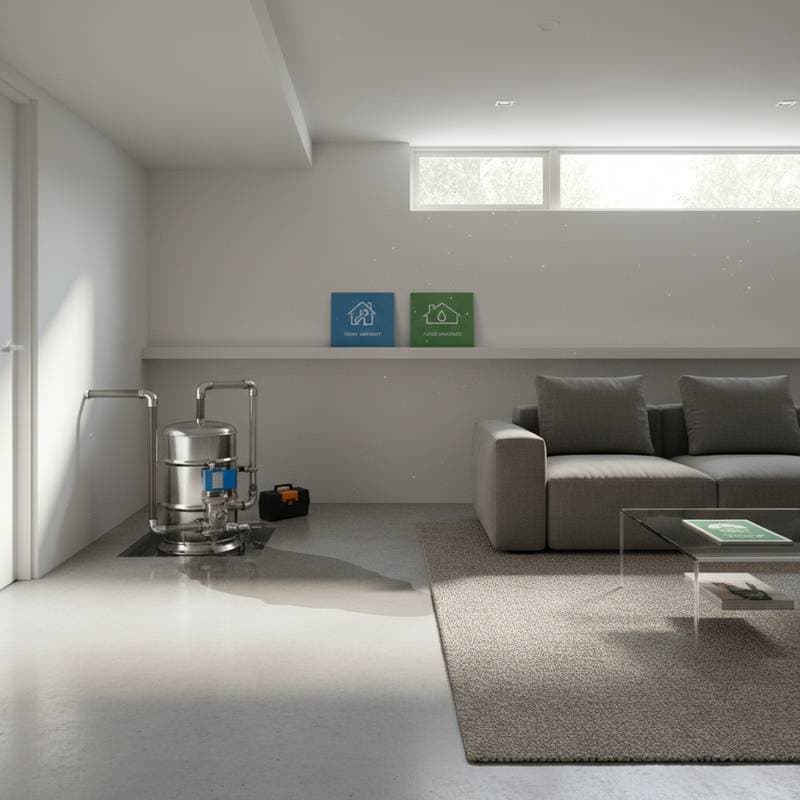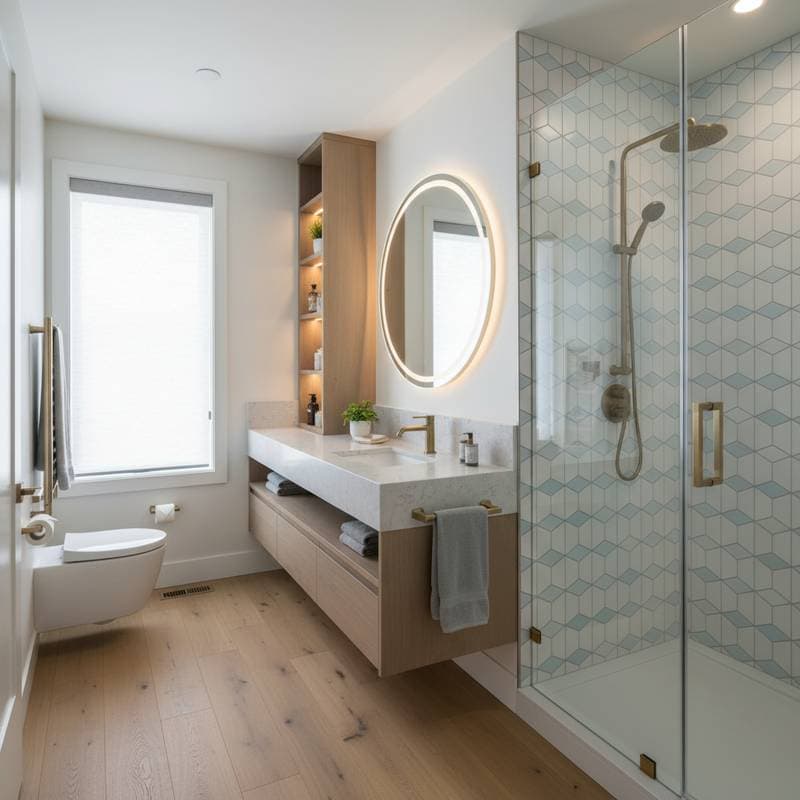Does Home Warranty Cover Sump Pump Flood Damage?
A flooded basement ranks among the most disruptive challenges for homeowners. When a sump pump malfunctions amid heavy rainfall, the resulting cleanup proves costly, labor-intensive, and stressful. Homeowners often turn to their warranty for relief, yet coverage applies selectively. Standard plans address the pump's mechanical failure but exclude water damage to the structure or contents.
This limitation stems from the warranty's focus on appliances and systems rather than property restoration. Grasping these boundaries equips you to select appropriate protections and avoid unexpected expenses during storms.
The Quick Answer
Standard home warranties include repair or replacement of sump pumps damaged by normal wear and tear. These plans target the device's components, such as the motor or switch, when failure arises from routine operation.
However, they exclude flood damage resulting from the pump's breakdown, including water intrusion into walls, floors, or stored items. Homeowners insurance or dedicated flood policies address such structural and personal property losses. This separation ensures warranties handle preventive equipment while insurance manages consequential harm.
Understanding What a Sump Pump Does
Sump pumps reside in a basin at the basement's lowest level, designed to expel excess water and prevent accumulation. Upon detecting rising water via a float mechanism, the pump activates and directs flow through a discharge pipe, typically extending 10 feet or more from the foundation to avoid recirculation.
Two primary types serve different needs:
| Type | Average Cost | Ideal Use | Lifespan |
|---|---|---|---|
| Pedestal sump pump | $150 to $350 | Shallow basements or crawl spaces | 15 to 25 years |
| Submersible sump pump | $250 to $600 | Deep pits or high-water areas | 8 to 15 years |
Regular upkeep sustains performance. Clear the basin of debris quarterly and test activation monthly by adding water. Failure allows water levels to climb 2 to 4 inches rapidly, compromising flooring, walls, and possessions.
What a Home Warranty Usually Covers
Home warranties protect key sump pump elements like the motor, impeller, and float switch against breakdowns from everyday use. Coverage activates for issues unrelated to neglect or external forces.
Consider these examples:
- Covered: Motor failure due to prolonged operation over time.
- Covered: Impeller damage from gradual wear.
- Not covered: Blockage from accumulated sediment in an uncleaned basin.
- Not covered: Inactivity during a power failure without backup.
Providers impose per-item caps, typically $500 to $1,500, with homeowners covering excesses. Exclusions often apply to specialized setups, such as pumps linked to septic systems or exterior drainage.
Why Flood Damage Is Rarely Covered
Warranties prioritize mechanical repairs over comprehensive damage mitigation. Thus, while they fund pump fixes, they omit expenses for water extraction, structural drying, or content salvage following a failure.
Restoration demands escalate quickly; even minor flooding in a 500-square-foot area incurs $15 to $25 per square foot for carpet, drywall, and insulation replacement, often surpassing $5,000 total. Homeowners or flood insurance fills this gap, particularly in groundwater-prone regions.
Separate flood policies provide essential backup, covering overflows beyond standard perils.
When Homeowners Insurance Steps In
Standard homeowners policies protect against abrupt water events, such as pipe bursts, but exclude groundwater flooding or sump pump overflows without add-ons.
A sump pump failure endorsement, also known as water backup coverage, extends protection to include:
- Water removal and dehumidification.
- Floor and wall repairs.
- Salvage of affected personal items.
- Mold prevention measures.
Limits vary from $5,000 to $25,000, with annual premiums around $50 to $150. This rider transforms potential disasters into manageable claims post-rainfall.
Common Scenarios and How Coverage Works
Coverage varies by incident type. Review this table for typical outcomes:
| Scenario | Home Warranty | Homeowners Insurance | Flood Insurance |
|---|---|---|---|
| Pump motor fails from wear | Covered (pump repair) | Not covered | Not applicable |
| Flooding after pump failure | Pump only | Covered with endorsement | Covered if groundwater |
| Power outage disables pump | Not covered | Not covered | Not covered |
| Heavy rain floods without pump issue | Not covered | Not covered | Covered |
| Debris clogs pump causing failure | Not covered (maintenance) | Not covered | Not covered |
Warranties target equipment reliability; insurance addresses fallout. Layering both maximizes security without overlap.
What to Check in Your Warranty Contract
Policies differ across providers, so scrutinize your agreement for clarity.
- Coverage limit: Confirm the maximum payout for pump services.
- Exclusions: Identify restrictions on flood-related claims.
- Maintenance proof: Note requirements for upkeep records.
- Service fee: Anticipate $75 to $125 per visit.
- Response timeline: Ensure prompt dispatch, especially in wet seasons.
Contact your provider for written confirmation on pump and damage coverage to eliminate ambiguities.
DIY Maintenance That Prevents Warranty Denials
Neglect voids many claims, as providers deem preventable issues outside scope. Implement this routine to maintain eligibility and functionality.
- Examine the basin quarterly: Extract leaves, dirt, or gravel impeding flow.
- Test the float monthly: Simulate activation with water and verify shutdown.
- Flush the discharge pipe biannually: Hose out mineral deposits.
- Verify backup systems: Charge batteries or inspect water-powered alternatives.
- Upgrade old units: Swap pumps over 10 years to avert sudden breakdowns.
These steps minimize risks and preserve warranty terms.
Common Mistakes Homeowners Make
Overconfidence leads to oversights that amplify costs. Steer clear of these pitfalls:
- Relying on assumptions: Verify policy details rather than presuming full flood protection.
- Overlooking upkeep: Sediment buildup shortens component life and invites denials.
- Dismissing alerts: Address humming, extended run times, or corrosion promptly.
- Crowding the pit: Maintain 12-inch clearance for unobstructed operation.
- Neglecting backups: Test secondary power sources annually to ensure reliability.
Proactive habits convert vulnerabilities into strengths.
Accessibility Considerations
Mobility challenges complicate sump pump oversight. Opt for adaptations that simplify tasks:
- Pedestal models: Elevate the motor for reach without deep bending.
- Audible alarms: Alert to rising water levels audibly.
- Smart monitors: Wi-Fi devices notify via app for remote checks.
- Professional audits: Schedule yearly visits at $100 to $200 for thorough evaluations.
These features enhance safety and prolong equipment durability.
When to Hire a Professional
Self-maintenance suffices for basics, but experts handle complexities. Engage a specialist if:
- The pump cycles nonstop in dry conditions.
- Corrosion appears on housing or fittings.
- Excessive vibration occurs during operation.
- Discharge backs up or freezes.
- Installation of backups or dual systems is needed.
Technicians assess electrical load, valve integrity, and pipe gradient (minimum 1-inch drop per foot) to optimize drainage and prevent foundation threats.
Estimating Costs and Comparing Options
Pump repairs average $200 to $500; full replacements span $400 to $1,200 based on specifications. Battery backups add $250 to $800.
Contrast these with flood remediation: Extraction costs $3 to $7 per square foot, while complete overhauls in finished spaces exceed $10,000. Such disparities underscore the value of warranties for parts and endorsements for damages.
Building Comprehensive Protection
Effective defense integrates equipment care with robust policies. Start with routine sump pump testing to catch issues early.
Secure a home warranty for mechanical safeguards on the pump. Add homeowners endorsements or flood insurance to cover water impacts.
This trio delivers layered security, minimizing disruptions and preserving your home's integrity against water threats.





